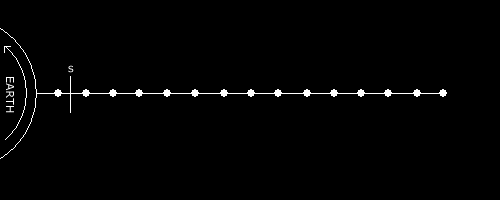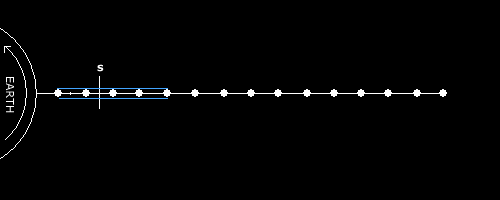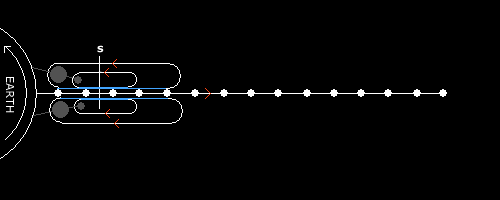
Tension Bracing of Orbital Siphons
Pearson's 1975 tower tapered from a maximum cross-sectional area at synchronous down to a minimum at either end. Since tension maximum lies at synchronous, the result was constant tension per unit cross-sectional area along the entire length of the tower.
With an orbital siphon, however, it isn't possible to taper the rising chain of masses, and the result is that maximum tension per unit cross-sectional area will occur at synchronous.

In this circumstance, it would be helpful if additional tension bracing could be added to the chain as it passed through synchronous. Such additional bracing could act to reduce the tension per unit cross-sectional area as maximum tie tensions were reached around synchronous.

And, in principle, it might be possible to do this if the tension bracing was in the form of a closed loop, like a caterpillar track, which maintained its radial distance from the Earth, rolling down the rising chain of masses.

But several problems would seem to attend this approach.
In the first place, there would very likely be a tendency for the bracing belt not to remain at synchronous, but to simply be carried up with the rising tower, and ejected into space. Therefore it is probably necessary to tie the belts to the surface of the Earth, to prevent them from rising, and keep them turning around synchronous.
A second problem would be one of how to attach and detach the leading and trailing ends of the bracing belt to the rising train. How could the belt have tension applied to it to match that within the rising tower? The answer is that there may be no need to match tensions, but simply attach an untensioned belt below synchronous, and allow it to come into increasing tension as it rose towards synchronous, and then have its tension decrease as it passed beyond synchronous, until all tension had vanished from it, and the belt could be released to fold back and return untensed through synchronous. A variant of this approach would be to change Young's modulus for the belt so that the stress within it rose more sharply with strain than the ties within the rising tower, so as to ensure that at peak tension all bracing was in approximately equal tension.
And if this was successful, additional bracing belts could be added, one inside the other, to add further bracing.

Perhaps a final development of this bracing belt system might be to extend it to include the whole tower, with all ties between masses removed. The result would be that only payloads would be released into space at the top of the tower, and all bracing belts would continually cycle on the tower.
The principal advantage of this would be that tension bracing would be recycled rather than ejected into space.

In addition, a revolving belt system might also allow returning spacecraft to catch the down train on the outer loop of the bracing belts, which would be travelling down the tower at the same speed as the tower rose.
